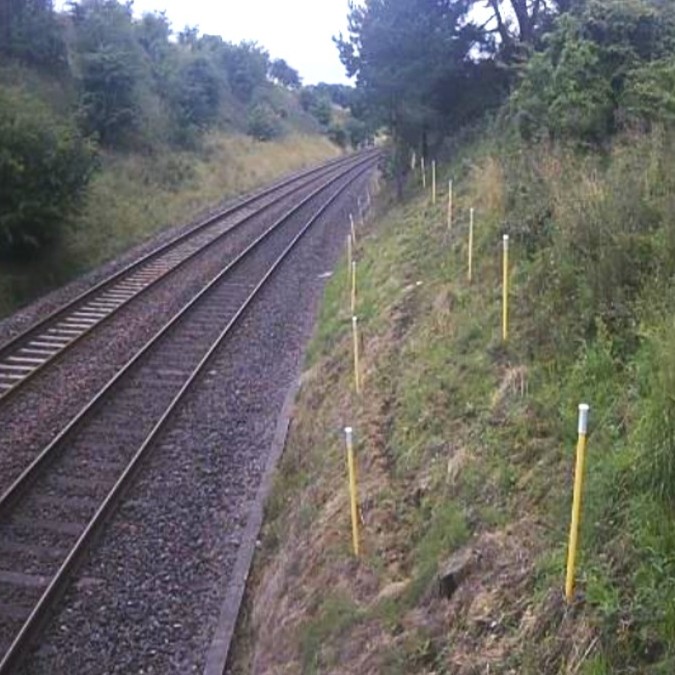For two centuries rail has been a transport backbone moving goods and people. Rail routes have conquered challenging terrain by carving paths through rugged landscapes and building bridges where needed. This rail route legacy relies on extensive earthworks, cuttings, embankments, and slopes to maintain the shallow gradients needed for reliable operation.
What happens when these engineered slopes age? What happens when they slip, slide or fail?
At best, a railway landslide is a major service disruption; at worst, it's a disaster.
The Growing Rail Landslide Threat
Earth movements wreak havoc on tracks, leading to operational shutdowns that can last for days, weeks, or even months while stabilisation and material removal take place.
Almost universally we observe landslide events occurring with increased frequency with many predicting the rise to continue. Some attribute this to more frequent extreme weather events, some blame aging or neglected infrastructure and others point the finger of blame at climate change. In reality all are likely contributors to an increasing rise in reported rates of failure across many railways and railroads.
Recent railway landslides serve as stark reminders of this persistent threat:
- The Carmont Derailment in the UK highlighted how even a small amount of material in the wrong place can be catastrophic as gravel and debris washed onto the track, caused a fatal derailment.
- The 2024 Finneidfjord derailment in Norway claimed the drivers life and was one of 863 mudslides and rock falls on Norwegian railways over the previous decade.
- The Riedlingen derailment in Germany in 2025 bore many striking similarities to Carmont, killing 3 and injuring dozens more when a train struck debris washed onto the tracks by heavy rain.
 The debris across the track that resulted in the fatal derailment at Carmont.
The debris across the track that resulted in the fatal derailment at Carmont.
Photo from accident report here
The Danger Zone
The most dangerous period for railway landslides usually occurs after the slope fails, but before it is identified by operations teams. The risk of trains striking obstructed tracks at speed poses an existential risk to trains and the passengers, freight and staff they carry.
Traditionally many railways rely on visual inspections and train staff reports to spot unstable slopes, a process fraught with limitations especially when extreme weather events are a common trigger for failure to occur. When a driver sees a landslide across the route, it is often too late to stop before a collision with the debris or before the train travels over potentially displaced, compromised track.
It is therefore essential that landslides are identified as they occur, rather than as they are found by train crews.
The Limitations of Traditional Monitoring
Where slopes are known to be high-risk, trackside sensors can be deployed to monitor slope movements. However, to provide adequate detection resolution across a long slope you might need many many sensors, e.g., over 100 tilt sensors to monitor a 150m long cutting. Each sensor requires installation (into a potentially unstable slope), together with power, maintenance, and supporting communications infrastructure.
This high sensor count required makes protecting large lengths or entire rail routes impractical and prohibitively costly, limiting their application to shorter lengths of high-risk slopes or those that are known to be moving, leaving a significant proportion of the route unprotected. Other measurement options, like wire sensors, are prone to false alarms and need disruptive on-site resets, further limiting their widespread application.
Despite spending tens of millions of pounds on remote monitoring less than 10% of UK landslides were identified by remote sensors.
 Pole mounted tilt sensors spaced at 2.5m intervals for monitoring slope movement. Photo from Network Rail
Pole mounted tilt sensors spaced at 2.5m intervals for monitoring slope movement. Photo from Network Rail
What new landslide monitoring techniques are there?
Distributed Acoustic Sensing (DAS) provides a powerful alternative to traditional visual methods or multi-sensor instrumentation systems. DAS has the potential to deliver whole route monitoring for landslides in real-time.
DAS harnesses the power of fiber optic cables (often already present alongside railway infrastructure for signalling and telecoms). By sending laser pulses down the cable and analysing the reflected signal, the technique turns the fiber length into a continuous, sensitive vibration sensor many tens of kilometres in length.
This detection technique makes it an extremely sensitive tool for detecting the ground vibrations generated by landslides, mudslides, and rockfalls, acting as an invisible, continuous safety warden listening out for trouble.
For more on how DAS works see here.
Calculate how many slope sensors you can save?
Why consider Distributed Acoustic Sensing for railway landslide detection?
Comprehensive Coverage |
A continuous trackside fiber means no gaps between sensors. |
Fewer Sensors, More Range |
Sensonic DAS monitors up to 80km of route per device. Entire route protection is within reach. |
Improved Response Time |
Alerts within seconds, located within metres. |
Reduced Installation Costs |
If fiber is present, no new trackside equipment is needed. DAS can often use existing fiber. |
Scalability |
Entire route protection can be deployed in weeks rather than years. |
Reduced Maintenance Risks |
No routine sensor maintenance and fiber lasts for decades. No unstable slopes to climb to install, or change batteries in sensors. |
Want to find out more about our landslide or rockfall protection?
Landslide Monitoring Rockfall Monitoring
Header Image courtesy Metropolitan Transportation Authority of the State of New York, CC BY 2.0, via Wikimedia Commons


